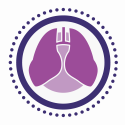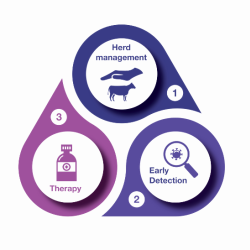- M. Stöber (2006): “Krankheiten der Atmungsorgane, des Zwerchfells und der Brustwand.” in G. Dirksen, H.-D Gründer, M. Stöber, et al., eds. Innere Medizin und Chirurgie des Rindes. 5th ed. Parey in MVS Medizinverlage Stuttgart GmbH & Co. KG 2006, pp. 271-356.
- Pardon, B., De Bleecker, K., Hostens, M. et al. “Longitudinal study on morbidity and mortality in white veal calves in Belgium.”; BMC Vet Res 8, 26 (2012).
- Abuelo A., Cullens F., Brester J.L. 2021. Effect of preweaning disease on the reproductive performance and first-lactation milk production of heifers in a large dairy herd. Journal Dairy Science (104), p. 7008-7017.
- Pardon B., Callens J., Maris J., van Praet W., Deprez P., Ribbens S. 2020. Pathogen-specific risk factors in acute outbreaks of respiratory disease in calves. Journal Dairy Science (103), p. 2556 – 2566.
- Mijares et al. (2023) “Veterinarians” perspectives of pain, treatment, and diagnostics for bovine respiratory disease in preweaned dairy calves. Front. Pain Res. 4:1076100.
- B. Pardon et S. Buczinski, (2020): “BRD Diagnosis What Progress Has Been Made in Infectious Diagnosis?”.
- Antonis A. F. G. et al. (2022): “Respiratory pathogens in veal calves: Inventory of circulating pathogens”; Veterinary Microbiology 274, (2022) 109571.
- MS. Martin et al. (2022): “Assessment of pain associated with bovine respiratory disease and its mitigation with flunixin meglumine in cattle with induced bacterial pneumonia.”
Bovine respiratory disease (BRD)
a complex disease, a complex challenge
What is BRD?
Bovine Respiratory Disease is also known as bovine enzootic bronchopneumonia, shipping fever, or crowding disease (in most cases associated with the transport and assembly of large groups of recently weaned calves).
BRD is a term encompassing upper and lower respiratory tract disorders.1 The highest incidence of BRD is usually associated with shipping or comingling of animals upon or after weaning. Clinical symptoms appear 1-2 weeks after the initial incident with potential morbidity of over 80%.1
BRD accounts for about a quarter of calves’ deaths and a large proportion of antibiotic use in calves.2 It is a multifactorial condition with a major economic impact not only upon the clinical disease but also throughout the animal’s life.3
Therefore, early detection and treatment, with correct preventive measures are essential to ensure good animal welfare. Epidemic respiratory outbreaks peak in winter and are primarily of viral origin.4

Is BRD a painful condition?
Most veterinarians have considered BRD as a mild to moderately painful condition.5 Recognizing that cows are in pain is very difficult because these animals are stoic by nature and usually mask the signs of pain. To support the assessment of pain, some methods have been developed.
file_download Learn more about how to detect and control pain in cattle
What are the symptoms of BRD?
To support you in the assessment of animal's health we have developed a checklist.

Which pathogens are associated with BRD?
The BRD complex can be caused by an infection of single or multiple pathogens. Respiratory disease peaks in the winter months and is primarily of viral origin, but both viruses and bacteria can be associated with BRD.1,2
Respiratory infections associated with viruses (as BRSV, BHV-1 or Parainfluenza virus type 3) or with bacteria as Mycoplasma bovis are often silent displaying little clinical symptoms. These pathogens affect local immune cells causing their most dangerous effect: immune suppression, making the host calf more susceptible to infection with opportunistic bacteria.1 But if these pathogens are detected in an animal, they can be directly suspected as causing agent of BRD, as they should not be present in healthy calves.1
Bacterial pathogens as Mannheimia haemolytica, Pasteurella multocida or Histophilus somni have often been associated with the more acute cases of BRD. It is safe that these bacteria are not likely to cause the disease by themselves since they are frequently isolated also from healthy animals.4,6,7
Given the importance of responsible use of antibiotics and targeted treatment, there is a growing need for sampling the deep airways to determine the causative pathogens and their susceptibility before initiating treatment.

Why are cattle so prone to respiratory diseases?
Understanding the natural predisposition of cattle to lower respiratory tract diseases is of great importance in the development of the disease process and the impact respiratory disease can have on calves:

add
The lungs of this species mature late, completing their physiological development at around 12-13 months of age.1

add
The ratio of gas exchange surface area to body weight is the most unfavourable of all livestock in this species.

add
Cattle have more interstitial tissue in the lungs, which limits the flexibility of lung tissue.

add
Cattle show a fibrinous inflammation pattern: they respond to tissue damage by producing fibrinous exudates resulting in fast scarring of the damage but rendering the damaged tissue less likely to resolve back to its original state.

add
Cattle have a lower temperature neutral zone compared to humans. They are much more prone to suffer from heat stress. Respiratory distress accelerates this.
What are the risk factors of BRD?
BRD is a complex disease which is favoured by many factors related to the animal, the circulating pathogens and the husbandry conditions. Under optimal conditions, all these factors are in a state of specific equilibrium, preventing the onset of disease.
Good husbandry
- Stress
Stress plays a pivotal role in an animal’s immune competence. Transport, weaning, nutrition, co-mingling, separation from the dam as well as zootechnical procedures like disbudding and castration increase the stress level of calves. Environmental stressors are major drivers of the disease. That is why good herd management (adequate nutrition, housing conditions, climate, colostrum regimen) is ever so important. - Time period of the year
In Europe BRD related pathogens have been shown to be diagnosed most in between autumn and spring.² The epidemic disease peaks in winter months.² During this time even grazing cattle are housed indoors, increasing the stocking density or having multiple age groups present within one barn. - Climate
Climate conditions during this period can also prove to be challenging. Make sure calves are always housed in a dry environment with sufficient bedding material available. Ensuring sufficient fresh air supply whilst avoiding draft around the animals can prove to be challenging.
How is BRD diagnosed?
Observing the first signs of the disease is key to a successful treatment plan and preventing further infections. Early detection can be tricky as calves do not display apparent clinical symptoms immediately. But if not spotted in time the infected calves can become severely ill leading to a high mortality rate.
If there are already casualties on a farm and a herd wide infection is looming and you have the capacities to perform necropsies, it is a useful tool to learn from the dead and take control of the situation.4
As a rule of thumb, the earlier diagnostics samples are taken, the more likely it is to isolate the causative pathogen.6 Different sampling methods are available, of which deep nasopharyngeal swabs, transtracheal washes, and nonendoscopic broncho-alveolar lavage (nBAL) have been suggested but are sometimes not regularly considered.5
Besides classical bacterial culture and susceptibility testing, PCR tests are also becoming increasingly popular. PCR can be advantageous to screen for many different pathogens (both bacteria, and viruses) and its high sensitivity allows the examination of pooled samples.
This video shows an example of one of a diagnostic approach. As mentioned before one of the method which can be used by a vet is performing transtracheal wash.

How to treat BRD?
Antimicrobial therapy is frequently used because of the involvement of bacterial agents in BRD. Success of antibiotic treatment protocols depend on the timing of the treatment, pathogen identification and its susceptibility.
During a survey among veterinarians all respondents considered BRD infections in calves at least mildly painful.5 Use of an NSAID as an addition to antimicrobial contributes to faster drop in body temperature, and resolves average activity levels.8
It is recommended to implement supportive treatment, i.e., mucolytics to make breathing easier by relaxing the muscles in the lungs and widening the airways. Sufficient and high-quality nutrition supports the recovery. In addition to that separating sick animals from healthy housemates is also very relevant to stop the infection chain and protect the rest of the herd.

How does BRD impact animal welfare and farm performance?
Studies have stated that BRD is responsible for nearly one-fourth of calf mortality.2
- Directs costs are related to production losses at farm level by deaths and reduced carcass quality, treatment costs, labour costs.
- Indirectly, BRD is impacting the herd breeding performances.
Reduced fertility
Calves with BRD history have lower rates of weight gain, which can eventually lead to a lower body weight at 14 months of age (+/- 24 kg less than average). As a result, they reach the sexual maturity later. The calving age is about 0.5 to 6 months later, the age of 1st insemination is up to 20 days later and during the calving there is a higher risk of dystocia.3
Lower milk yield
Calves with severe BRD infection in the first 3 months of life will produce 150 kg less milk in the 1st lactation. Calves with mild BRD infection in the first 6 months of life produce 110 kg less milk on average.3
Higher culling rate
An increased risk of early culling is higher in calves with BRD history.3
5 Key points to remember
- BRD in calves is a painful condition which requires effective pain management.5
- BRD is a multifactorial problem – the onset depends on the presence of the causative pathogens, animal’s general condition and husbandry factors.
- Anatomically, cattle are more predisposed to respiratory diseases.1
- The economic impact of BRD is significant. Multiple studies have stated that BRD is responsible for nearly one-fourth of calf deaths.2,8
- BRD management requires an integrated approach.
Authors
Aleksandra Krawczyk, DVM
Technical Manager Cattle
Dechra Veterinary Products

Matthias Riedel, DVM
Business Manager Cattle and Vaccines
Dechra Veterinary Products

References add


